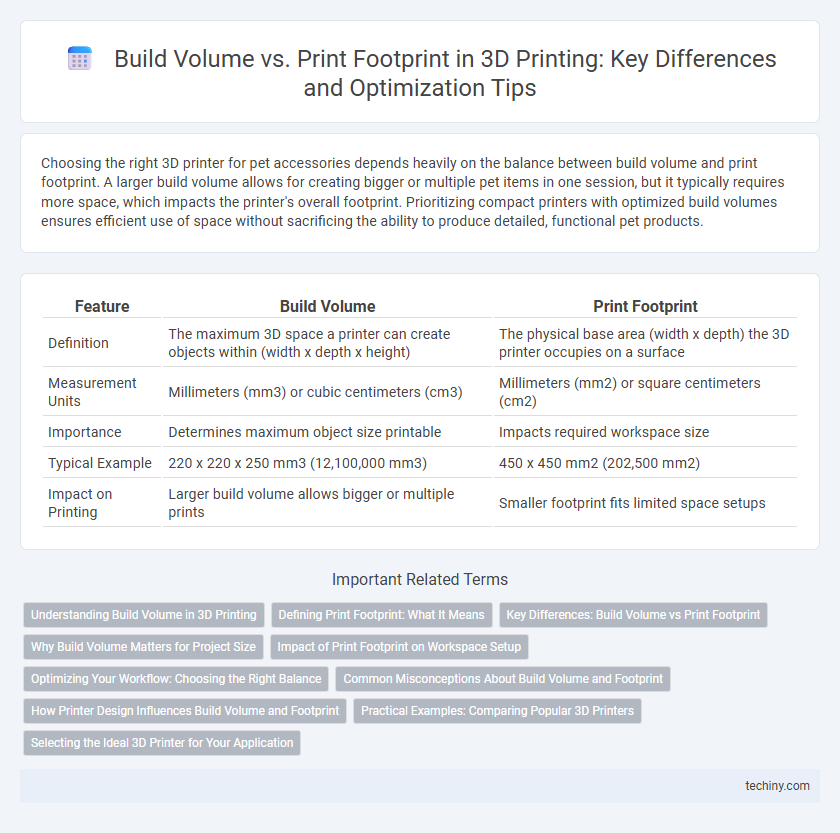Choosing the right 3D printer for pet accessories depends heavily on the balance between build volume and print footprint. A larger build volume allows for creating bigger or multiple pet items in one session, but it typically requires more space, which impacts the printer's overall footprint. Prioritizing compact printers with optimized build volumes ensures efficient use of space without sacrificing the ability to produce detailed, functional pet products.
Table of Comparison
| Feature | Build Volume | Print Footprint |
|---|---|---|
| Definition | The maximum 3D space a printer can create objects within (width x depth x height) | The physical base area (width x depth) the 3D printer occupies on a surface |
| Measurement Units | Millimeters (mm3) or cubic centimeters (cm3) | Millimeters (mm2) or square centimeters (cm2) |
| Importance | Determines maximum object size printable | Impacts required workspace size |
| Typical Example | 220 x 220 x 250 mm3 (12,100,000 mm3) | 450 x 450 mm2 (202,500 mm2) |
| Impact on Printing | Larger build volume allows bigger or multiple prints | Smaller footprint fits limited space setups |
Understanding Build Volume in 3D Printing
Build volume in 3D printing defines the maximum dimensions (width, depth, height) an object can be printed, directly impacting the size and complexity of projects. It differs from print footprint, which refers to the physical space the printer occupies, influencing workspace arrangement and portability. An optimized build volume allows for larger or multiple objects per print cycle, enhancing efficiency and creativity in additive manufacturing.
Defining Print Footprint: What It Means
Print footprint refers to the physical dimensions of the base area that a 3D printer occupies on a surface, typically measured in millimeters or inches. It defines the amount of workspace a printer requires, influencing where it can be placed in a workshop or office. Unlike build volume, which measures the maximum size of an object the printer can create, the print footprint focuses on the printer's overall size and spatial footprint.
Key Differences: Build Volume vs Print Footprint
Build volume refers to the maximum physical size an object can be printed within a 3D printer, defined by its X, Y, and Z dimensions. Print footprint denotes the actual space the 3D printer occupies on a workspace or desk, typically smaller than or equal to the build volume area. Understanding the difference helps optimize workspace planning and project scale choices, ensuring efficient 3D printer usage and material handling.
Why Build Volume Matters for Project Size
Build volume directly influences the maximum size of objects a 3D printer can produce, determining the scale and complexity of projects possible. Larger build volumes enable the fabrication of sizable prototypes, architectural models, and functional parts without segmentation, reducing assembly time and improving structural integrity. Choosing a printer with an appropriate build volume ensures alignment with project requirements, optimizing efficiency and output quality.
Impact of Print Footprint on Workspace Setup
A smaller print footprint allows for more efficient use of limited workspace, enabling users to fit larger 3D printers or multiple devices within confined areas. Optimizing print footprint reduces clutter and improves accessibility to tools and materials, enhancing overall workflow during large-scale or complex build volume projects. Selecting a printer with a compact footprint balances workspace constraints without sacrificing the required build volume for precise and detailed 3D prints.
Optimizing Your Workflow: Choosing the Right Balance
Selecting the optimal build volume relative to the print footprint is crucial for enhancing 3D printing efficiency and maximizing production capacity. A larger build volume allows for printing bigger or multiple parts simultaneously, reducing batch times, while a compact print footprint conserves space in work areas, essential for small workshops or desktop setups. Balancing these factors ensures effective workflow optimization, minimizing material waste and post-processing time without compromising precision or scalability.
Common Misconceptions About Build Volume and Footprint
Common misconceptions about build volume and print footprint often confuse these two key 3D printing specifications. Build volume refers to the maximum three-dimensional space a printer can create within, while print footprint indicates the physical surface area the printer occupies on a desk or workspace. Understanding the distinction helps users select machines that balance part size capabilities with available workspace constraints.
How Printer Design Influences Build Volume and Footprint
Printer design directly impacts build volume and print footprint by determining the spatial efficiency and maximum printable object size within the device. Core components like the frame structure, motion system, and extruder arrangement influence how large the build platform can be while minimizing the overall printer footprint. Optimizing printer design for compactness enables larger build volumes in limited spaces, enhancing usability in constrained work environments.
Practical Examples: Comparing Popular 3D Printers
The Creality Ender 3 V2 offers a build volume of 220 x 220 x 250 mm while maintaining a compact print footprint of 475 x 470 mm, making it ideal for desktop use. In contrast, the Prusa i3 MK3S+ boasts a slightly smaller build volume of 250 x 210 x 210 mm but features an efficient print footprint of 550 x 520 mm, balancing workspace and print capacity. The Anycubic Chiron stands out with a massive 400 x 400 x 450 mm build volume but requires a large print footprint of approximately 600 x 600 mm, suited for users prioritizing maximum print size over space savings.
Selecting the Ideal 3D Printer for Your Application
Choosing the ideal 3D printer involves balancing build volume and print footprint to match your specific application needs. A larger build volume enables printing bigger or multiple parts simultaneously, while a smaller print footprint conserves workspace in compact environments. Assessing the required part size and available workspace ensures optimal printer selection for efficient and precise manufacturing.
Build Volume vs Print Footprint Infographic

 techiny.com
techiny.com